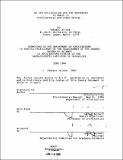| dc.contributor.advisor | Julian Beinart. | en_US |
| dc.contributor.author | Arioka, Takashi | en_US |
| dc.contributor.other | Massachusetts Institute of Technology. Dept. of Architecture. | en_US |
| dc.date.accessioned | 2012-06-05T13:51:08Z | |
| dc.date.available | 2012-06-05T13:51:08Z | |
| dc.date.copyright | 1986 | en_US |
| dc.date.issued | 1986 | en_US |
| dc.identifier.uri | http://hdl.handle.net/1721.1/71052 | |
| dc.description | Thesis (M.S.)--Massachusetts Institute of Technology, Dept. of Architecture, 1986. | en_US |
| dc.description | MICROFICHE COPY AVAILABLE IN ARCHIVES AND ROTCH | en_US |
| dc.description | Includes bibliographical references (leaves 182-189). | en_US |
| dc.description.abstract | The problem of observer in contemporary physics, or Heisenberg's principle of uncertainty and Einstein's theory of relativity had considerable strong impact on our notion of time and space. We are in the irreversible arrow of time and space continuum, and we call them lived space and lived time, which are completely different from abstract time and space in mathematics and physics. At the same time we came to know that we can only understand the world within the limit of our cognitive process. In cognitive process acquisition of language is essential to our having the capacity to convert sensory information into digital form. So our knowledge and belief are selective and exclusive. Epi-genetic process in biology and linguistics placed an impact on the understanding of the repetitive productions of architectural spaces in the city. What we did and are doing in the architectural and urban design process is regarded as something epi-genetic. To succeed to the precedents means one of the evolutional processes of the urban space from the genetic point of view, and Contextualism is regarded as one pattern of symbiosis from the ecological point of view. Design of architectural and urban space cannot do away with models. In decision making process, typological alternative studies are useful for selecting the most favorable ideas. This operation is truly regarded as a simulating process in our model of thought, which is similar to the mathematical or physical point of view. In this process decision is ultimately dependent on the characteristics of our cognitive process. Every selection is done thorough the mesh of our experiences and knowledge. This cognitive process transforms pattern of our sensation from the highly informationized urban space reacently. Various media have gradually influenced our visual experiences in the city. | en_US |
| dc.description.statementofresponsibility | by Takashi Arioka. | en_US |
| dc.format.extent | 141 leaves | en_US |
| dc.language.iso | eng | en_US |
| dc.publisher | Massachusetts Institute of Technology | en_US |
| dc.rights | M.I.T. theses are protected by
copyright. They may be viewed from this source for any purpose, but
reproduction or distribution in any format is prohibited without written
permission. See provided URL for inquiries about permission. | en_US |
| dc.rights.uri | http://dspace.mit.edu/handle/1721.1/7582 | en_US |
| dc.subject | Architecture. | en_US |
| dc.title | On the articulation and the synthesis of space in architectural and urban design | en_US |
| dc.type | Thesis | en_US |
| dc.description.degree | M.S. | en_US |
| dc.contributor.department | Massachusetts Institute of Technology. Department of Architecture | |
| dc.identifier.oclc | 15473019 | en_US |
